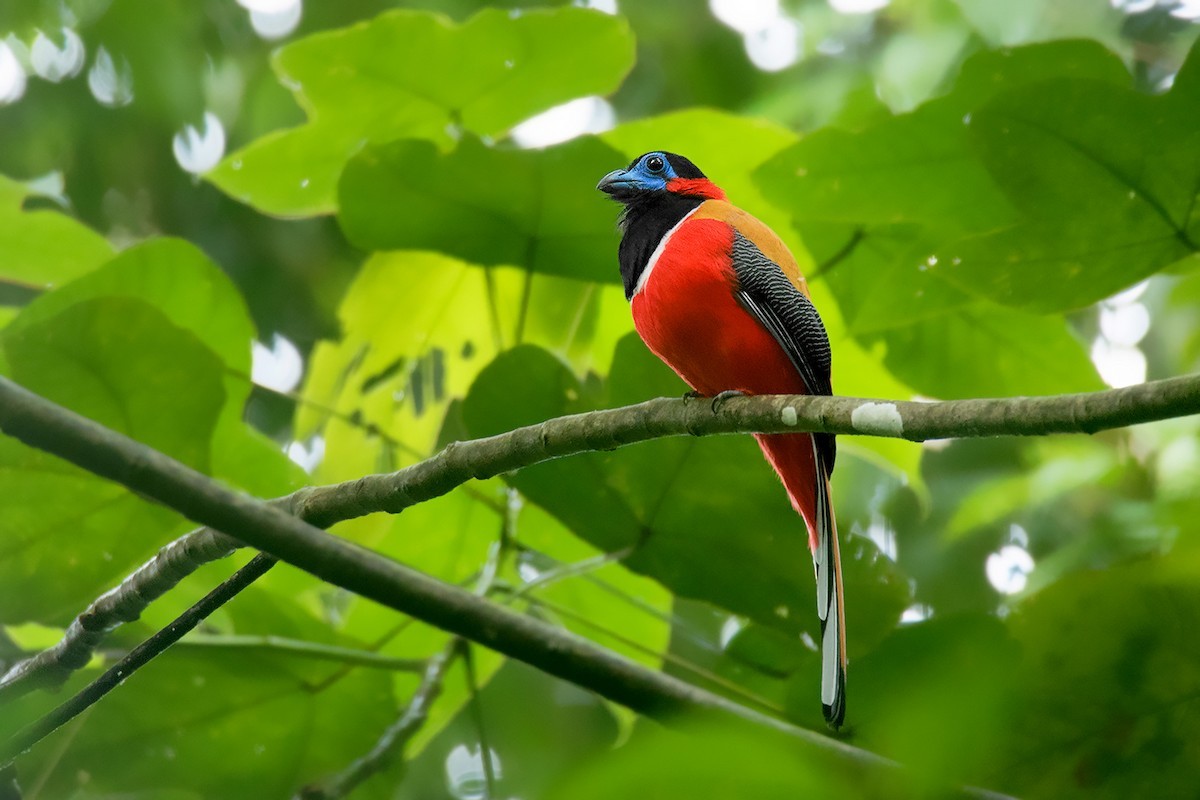Red-naped Trogon
A species of Asian trogons Scientific name : Harpactes kasumba Genus : Asian trogons
Red-naped Trogon, A species of Asian trogons
Botanical name: Harpactes kasumba
Genus: Asian trogons
Content
Description General Info
 Photo By Ayuwat Jearwattanakanok
Photo By Ayuwat Jearwattanakanok Description
The red-naped trogon (Harpactes kasumba) is a species of bird in the family Trogonidae. It is found in Brunei, Indonesia, Malaysia, and Thailand. Its natural habitat is subtropical or tropical moist lowland forests. It is threatened by habitat loss. 
Size
34 cm
Nest Placement
Tree
Feeding Habits
Red-naped Trogon primarily consumes arthropods, favoring stick insects and spiders, complemented by small lizards, fruits, and seeds. Feeding behaviors involve sally-glean flights from perches to snatch prey mid-air, utilizing serrated beak edges for securing and processing food.
Habitat
The red-naped Trogon inhabits predominantly the middle to upper strata of primary and selectively logged evergreen forests in lowland and foothill regions. This species also occupies peatswamp forests and is known to venture into upland and highland dipterocarp forests, lower montane forests, streamside vegetation, as well as modified landscapes such as shifting cultivation areas and cocoa plantations.
Dite type
Frugivorous
General Info
Feeding Habits
Bird food type

Fruit
Behavior
Red-naped trogons are generally inactive outside of their regular feeding patterns. Because of this, birdwatchers and biologists have noted that “apart from their general beauty, they are notorious for their lack of other immediately engaging qualities”. Their lack of activity has been considered a defence against predation. As with other Trogonidae species, red-naped trogons have been reported to shift along branches to keep their dull coloured backs turned towards observers, while their heads, which can rotate at 180 degrees like owls, are turned to keep watch on any potential predators. They are preyed upon by hawks and predatory mammals. 
Distribution Area
The red-naped trogon is presumed to be a permanent resident or sedentary bird. Sedentary is “commonly used in the special sense of ‘non-migratory,’” and resident is defined as “remaining throughout the year in the area under reference”. At least 4,000 species of bird are regular migrants, which is approximately 40 percentage of the world's population of birds, however the red-napped trogon is not one of these. It does not migrate, but instead remains in the same location all year round. Red-naped trogons are confined to the Sundaic regions lowlands, also known as Sundaland, with a distribution size of 989,000 km². The Sundaic lowlands is a biogeographical region of South-eastern Asia which encompasses the Sunda shelf, Malay Peninsula of the Asian mainland, and the large islands of Borneo, Java and Sumatra, including their surrounding islands. The eastern boundary of the Sundaic region is the Wallace Line which separates the Indomalaya and Australasia ecotones. The global population size has not been quantified, but the species is described as rare in Thailand, fairly common in Peninsular Malaysia and Sumatra, rather scarce in Sarawak and uncommon in Singapore, Indonesia, Sarawak, Sabah and Brunei. The current population trend shows a decline in the number of red-naped trogons at a moderately rapid rate, owing to habitat loss and degradation throughout its distribution range. Number of mature individuals = unknown Extreme population fluctuations = no Continuing decline of mature individuals = yes Population severely fragmented = no All individuals in one subpopulation = no Continuing decline in subpopulations = unknown Extreme population fluctuations in subpopulations = no 
Species Status
There are currently no targeted conservation actions for this species, however, conservation actions have been proposed to conduct ecological studies to improve the understanding of the red-naped trogon's habitat requirements. In particular, the studies would aim to determine the levels of tolerance of secondary habitats. Other conservation actions to be looked into are the improvement of management of protect areas within the species range, to increase the area of suitable habitat and the implement measures to ensure the protection of the suitable habitat from illegal activities. 

 Photo By Ayuwat Jearwattanakanok
Photo By Ayuwat Jearwattanakanok Scientific Classification
Phylum
Chordates Class
Birds Order
Trogons Family
Trogons and quetzals Genus
Asian trogons Species
Red-naped Trogon